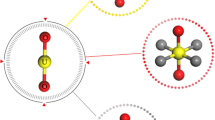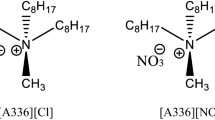Abstract
Suitability of TBP for recovery of uranium(VI) from dilute HNO3 using LEM extraction is investigated. TBP co-extracts significant amount of HNO3 along with U(VI). Beyond a critical time, extraction of U(VI) ceases due to attainment of critical acid level when the strip phase is unable to break TBP–U(VI) complex. The observed critical time is in good agreement with that estimated from rate of acid extraction. Optimal conditions at which the relative extraction of HNO3 is minimal with respect to U(VI) is arrived at. The extraction efficiency of TBP is compared with other ligands viz., TiAP, TEHP, TOPO, TOA and D2EHPA.












Similar content being viewed by others
References
El-Reefy SA, Selim YT, Aly HF (1997) Equilibrium and kinetic studies on the separation of uranium and thorium from nitric acid medium by liquid emulsion membrane based on trioctylphosphine oxide extractant. Anal Sci 13(3):333–337
Kulkarni PS (2003) Recovery of uranium(VI) from acidic wastes using tri-n-octylphosphine oxide and sodium carbonate based liquid membranes. CEJ 92(1–3):209–214
Macasek F, Rajec P, Rehacek V, Anh VN, Popovňáková T (1997) Emulsion membrane systems for preconcentration of uranium. J Radioanal Nucl Chem Lett 13(3):333–337
El-Hazek NT, El Sayed MS (2003) Direct uranium extraction from dihydrate and hemi-dihydrate wet process phosphoric acids by liquid emulsion membrane. J Radioanal Nucl Chem 257(2):347–352
El Sayed MS (2003) Uranium extraction from gattar sulfate leach liquor using aliquat-336 in a liquid emulsion membrane process. Hydrometallurgy 68(1–3):51–56
El-Reefy SA, Selim YT, Aly HF (1998) Recovery of uranium from thorium in hydrochloric acid medium by liquid emulsion membranes containing trioctylphosphine oxidem. J Radioanal Nucl Chem 228(1–2):21–25
Mukhopadhyay S, Ghosh SK, Juvekar VA (2008) Mathematical model for swelling in a liquid emulsion membrane system. Desalination 232:110–127
Kulkarni PS, Mukhopadhyay S, Bellary MP, Ghosh SK (2002) Studies on membrane stability and recovery of uranium(VI) from aqueous solutions using a liquid emulsion membrane process. Hydrometallurgy 64(1):49–58
Hirato T, Kishigami I, Awakura Y, Majima H (1991) Concentration of uranyl sulfate solution by an emulsion-type liquid membrane process. Hydrometallurgy 26(1):19–33
Guo J-X, Sun X, Du D-L, Wu X, Li M-X, Pang H, Sun S-X, Wang A-H (1991) Uranium(VI) extraction from chloride solution with benzyloctadecyldimethyl ammonium chloride (BODMAC) in a liquid membrane process. Hydrometallurgy 26(1):19–33
Abdelziz Y, Mohamed Y, Abdelmonem N, Karameldin A (2012) Studies on membrane stability for recovery of uranium from waste solution by liquid emulsion membrane (LEM). J Am Sci 8(12):1292–1297
Elsayed HM, Foaud EA, El-Hazek NMT, Khoniem AK (2013) Uranium extraction enhancement from phosphoric acid by emulsion liquid membrane. J Radioanal Nucl Chem 8(12):1763–1775
Das D, Juvekar VA, Roy SB, Bhattacharya R (2014) Comparative studies on co-extraction of uranium(VI) and different mineral acid from aqueous feed solutions using TBP, TOPO and TOA. J Radioanal Nucl Chem 300:333–343
Hesford E, McKay HAC (1960) The extraction of mineral acids by try-n-butyl phosphate (TBP). J Radioanal Nucl Chem 13:156–164
Foa E, Rosintal N, Marcus Y (1961) Three phase formation in the system hydrochloric acid–water-tri-n-butyl phosphate-diluent. J Radioanal Nucl Chem 23:109–114
Macasek F, Rajec P, Rehacek V, Anh V, Popovnakova T (1985) Emulsion membrane systems for preconcentration of uranium. J Radioanal Nucl Chem Lett 96(5):529–538
Girgin S, Acarkan N, Ali Sirkeci A (2002) The uranium(VI) extraction mechanism of D2EHPA–TOPO from a wet phosphoric acid. J Radioanal Nucl Chem 251(2):263–271
Macasek F (1992) J Radioanal Nucl Chem 163(3):239–250
Kenichi A, Hashimoto H (1986) Uranium(VI) transport through liquid membrane supported with trioctylphosphine oxide. Anal Sci 2:541–544
Acknowledgments
The author wishes to thank Quality Control Division of Uranium Extraction Division (QCS-UED), Bhabha Atomic Research Centre, India for allowing us to carry out the experimental work.
Author information
Authors and Affiliations
Corresponding author
Electronic supplementary material
Below is the link to the electronic supplementary material.
Rights and permissions
About this article
Cite this article
Das, D., Juvekar, V.A. & Bhattacharya, R. Problem associated with the use of TBP for LEM extraction of U(VI) and attempt to overcome this problem using other ligands. J Radioanal Nucl Chem 304, 1027–1042 (2015). https://doi.org/10.1007/s10967-014-3918-z
Received:
Published:
Issue Date:
DOI: https://doi.org/10.1007/s10967-014-3918-z




